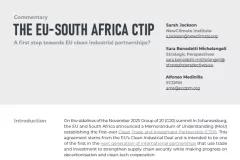The term 'greenhushing' has recently emerged in discussions around corporate climate action, but is it an actual trend? According to NewClimate Institute’s in-depth analyses across more than 70 corporate climate strategies since 2022, there is no indication of 'greenhushing.' Instead, major companies are retracting unsubstantiated carbon neutrality claims, which we consider a positive development. With emerging regulations and tighter voluntary standards on the horizon, there is potential for more transparent and factually accurate communication regarding companies' climate strategies. Rather than getting sidetracked by debates over the existence (or absence) of ‘greenhushing’, our focus should be on pushing for stricter regulations and voluntary standards to improve the transparency and integrity of corporate climate claims.
The questionable evidence behind ‘greenhushing’
In the absence of rigorous standards for companies' climate communications, there has been a notable gap between what some companies claim they are doing and their actual actions. This phenomenon is commonly referred to as greenwashing, a deceptive practice used by corporations to portray themselves as more sustainable than they truly are. More recently, newer terms such as of ‘greenhushing’ have gained prominence in discussions around corporate climate action (as highlighted in articles from The Washington Post or The Wall Street Journal).
Many statements in media coverage link back to two surveys conducted by the Swiss climate consultancy firm and carbon credit provider South Pole that asked large companies about their climate communications. South Pole claims to have identified a ‘greenhushing’ trend it labels as "going green, then going dark," a pattern observed in about a quarter of over 1,400 major companies surveyed. However, the findings should be taken with caution, given methodological limitations. The concept of ‘greenhushing’ still lacks a clear and universally accepted definition, with little empirical evidence proving its existence as an actual trend. The survey also lacked independent validation of company responses, which may be prone to confirmation bias.
This situation raises a critical question: Does the ‘greenhushing’ trend actually exist, and is it even worth debating over its existence when the narrative should be centred on actual solutions that could further drive corporate action?
Our analysis of corporate climate strategies shows no indication of ‘greenhushing’
If we define ‘greenhushing’ as backsliding from transparent and well-substantiated communication in corporate climate strategies, NewClimate’s in-depth CCRM series of analyses across a narrow sample of over 70 companies have found no indication of such backsliding. Instead, we observed a shift away from highly ambiguous and misleading carbon neutrality claims. Several companies, including Nestlé, Danone, Nike, Stellantis, and Volvo Group, seem to be stepping back from previously unsubstantiated carbon neutrality claims through offsetting, thereby enhancing the transparency of their climate communications.
For example, Danone has moved away from making carbon neutrality claims for its individual brands like Evian. At the same time, it has improved its climate strategy by making more transparent and substantiated pledges to reduce methane emissions from fresh milk by 30% by 2030 and to increase the share of plant-based products in its portfolio. Similarly, Volvo Group has shifted away from carbon neutrality claims related to specific manufacturing sites, while enhancing transparency in its communication by outlining specific and verifiable measures and targets to address their scope 3 value chain emissions. This includes investments in zero-emission vehicles, charging infrastructure, and sourcing low-carbon steel and aluminium. Other major companies such as Easyjet and Gucci, have also publicly announced a move away from offsetting and carbon neutrality claims and have now set emissions reduction targets instead.
If anything, these changes demonstrate — neither ‘greenhushing’ nor greenwashing — but a positive development towards more transparent, nuanced, and factually correct corporate climate communications. This means fewer ambiguous and misleading claims for consumers and other stakeholders. Ultimately, such an increase in transparency and specificity in corporate climate claims would further discourage companies from engaging in greenwashing practices.
Emerging regulations and tighter voluntary standards contribute to more transparent climate communication
If any companies hush about their unsubstantiated climate strategies, it could indicate that the companies are becoming more cautious in their claims, leaving less room for greenwashing practices. This could also be a sign of tighter regulations and voluntary standards beginning to have an impact on driving corporations towards more genuine climate pledges and action.
South Pole's recent survey findings highlighted that French and Swedish companies most frequently admit to resorting to 'greenhushing', primarily due to stricter regulations, increased scrutiny from customers, and insufficient data to substantiate their environmental claims. It is important to view these statements from EU-based companies in the context of the EU's forthcoming Anti-Greenwashing package, which includes The Directive on Empowering Consumers for the Green Transition and Green Claims Directive. These directives are likely to catalyse a shift towards more transparent corporate environmental disclosures by cracking down on misleading claims about their products or services. Moreover, stricter voluntary standards from influential organisations such as the Science-Based Targets initiative (SBTi), which recently removed unsubstantiated net-zero commitments of more than 200 companies in March 2024, might further contribute to this positive shift.
Rather than being distracted by the narrative of 'greenhushing', we should continue to advocate for more robust regulations and voluntary standards to enhance the transparency and integrity of corporate climate claims. This will drive companies to move beyond making vague green claims for marketing purposes and instead set measurable and transparent emissions reduction target, eventually pushing them towards a ‘race to the top’ in their climate action.
Project background
The challenge of distinguishing real climate leadership from greenwashing is significant. NewClimate introduced the Corporate Climate Responsibility Monitor (CCRM) project to evaluate the transparency and integrity of corporate climate strategies of 51 major global companies like Nestlé, Volkswagen Group, Nike, and Enel, responsible for 12% of global emissions in 2022. The CCRM, prepared by NewClimate Institute and supported by Carbon Market Watch, aims to provide a snapshot of the current state of corporate climate target setting, share information on emerging approaches for corporate climate leadership across different areas, and identify where clearer guidance or regulation is needed. The CCRM focuses on four main areas of corporate climate action: tracking and disclosure of emissions, setting emission reduction targets, reducing own emissions and taking responsibility for unabated and residual emissions.
Our CCRM analyses reveal gradual improvements in companies’ climate targets, though they remain insufficient and often unsubstantiated, with the looming threat of backsliding, particularly due to proposals to introduce further flexibility into companies’ scope 3 targets through offsetting. In 2022, we found that the ambiguity of companies’ climate targets made it nearly impossible to distinguish genuine environmental leadership from mere greenwashing, and the overall level of commitments was critically insufficient. In 2023, the median absolute emission reduction commitment across the full value chain among companies’ 2030 targets was 15%, and it has gradually improved to 30% in 2024. Even as we observe gradual improvements in targets, the real ambition behind these targets is called into question by the very mixed progress on critical sector transition plans. While some companies are advancing towards low-carbon transitions, others continue to distract and delay with false solutions.
→ See also the assessment methodology for the Corporate Climate Responsibility Monitor. Guidance and assessment criteria for good practice corporate emission reduction and net-zero targets: Version 4.0 (NewClimate Institute, 2024).





